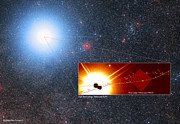Annuncio
Il futuro di Alpha Centauri
Prevista per il 2028 un’opportunità rara di caccia al pianeta attorno ad Alpha Centauri A
20 Ottobre 2016
Un team di astronomi francesi guidato da Pierre Kervella del CNRS/Università del Cile ha previsto che nel 2028 si verificherà un evento molto raro di lente gravitazionale, un’opportunità ideale per cercare la prova dell’esistenza di pianeti intorno a una stella vicina.
Utilizzando dati nuovi e d’archivio ottenuti con diversi telescopi dell’ESO [1], il team ha predetto, con un errore piccolissimo, le traiettorie del duo stellare in rapido movimento dal nome Alfa Centauri A e B. In questo modo hanno potuto stabilire ogni stretto allineamento che si verificherà da qui al 2050 tra la coppia di stelle di Alfa Centauri e le stelle vicine a loro nel cielo — che, in realtà, sono molto più lontane nello spazio [2].
Sebbene prevedere il futuro con una precisione così sorprendente sia soddisfacente, non si tratta della ricaduta più importante della ricerca; i risultati offriranno infatti un’opportunità unica di caccia ai pianeti nel sistema Alfa Centauri, in quanto ci permetteranno di cercare effetti secondari di lente gravitazionale. Il fenomeno della lente gravitazionale si verifica perché un oggetto massiccio, come una stella, distorce la struttura intrinseca dello spazio che lo circonda. La luce proveniente da un oggetto distante, quando passa vicino alla stella nel suo percorso fino a noi segue una traiettoria curva nello spazio deformato. Le stelle più vicine agiscono da lente, curvando la luce proveniente dall’oggetto distante. Nei casi più particolari questo fenomeno può generare un anello di Einstein, un cerchio di luce intorno alla stella in primo piano. Dato che la massa della stella vicina determina esattamente il modo in cui avviene la deviazione della luce, le deviazioni che avvengono per effetto della lente gravitazionale possono essere utilizzate per determinare l’esistenza, e in tal caso la massa, di pianeti.
Uno degli allineamenti più interessanti predetto dallo studio è quello tra la stella più massiccia nella coppia di stelle di Alfa Centauri, ovvero Alfa Centauri A, e una stella distante sullo sfondo — probabilmente una gigante rossa — soprannominata S5. Nel mese di maggio del 2028 ci sarà un’alta probabilità che la luce proveniente da S5 produrrà un anello di Einstein intorno ad Alfa Centauri A, un fenomeno che sarà osservabile con i telescopi dell’ESO [3]. Sarà un’opportunità unica per cercare oggetti planetari o di massa piccola nel sistema stellare più vicino a noi e sarà anche particolarmente emozionante alla luce della recente scoperta del pianeta Proxima b, che orbita intorno a Proxima Centauri, la terza stella del medesimo sistema stellare.
Note
[1] A causa delle vaste distanze, misurare i veri movimenti della maggior parte delle stelle è estremamente difficile; per questo, sono necessarie misurazioni incredibilmente precise e ampie osservazioni. Il team di astronomi ha utilizzato i dati raccolti nel 2007 dall’NTT (New Technology Telescope) e le nuove osservazioni dello strumento NACO installato sul VLT (Very Large Telescope). Questi dati sono stati integrati con quelli di ALMA (Atacama Large Millimeter/submillimeter Array) per ottenere misurazioni ad alta precisione delle posizioni relative di Alfa Centauri A e B.
[2] Data la vicinanza del sistema Alfa Centauri al piano della Via Lattea, il campo stellare distante è molto densamente popolato: perciò il team aveva una buona probabilità di trovare una stella sullo sfondo che si allineasse quasi perfettamente con una stella della coppia di Alfa Centauri.
[3] L’evento sarà osservabile con lo strumento GRAVITY installato sul VLTI (Very Large Telescope Interferometer), con ALMA (Atacama Large Millimeter/submillimeter Array) e con il futuro E-ELT (European-Extremely Large Telescope), grazie al quale si avranno buone possibilità di stabilire con grande precisione la massa di qualsiasi pianeta.
ALMA, una struttura astronomica internazionale, è frutto di una collaborazione tra l'ESO, la U.S. National Science Foundation (NSF) e i National Institutes of Natural Sciences (NINS) del Giappone in collaborazione con la Repubblica del Cile.
Ulteriori informazioni
Questa ricerca è stata presentata in un articolo apparso il 19 ottobre sulla rivista Astronomy and Astrophysics (Kervella et al. 2016, A&A, 594, A107).
Il team è composto da: P. Kervella, CNRS UMI 3386, Università del Cile e LESIA, Osservatorio di Parigi; F. Mignard, Osservatorio della Costa Azzurra, Francia; A. Mérand, ESO; e F. Thévenin, Osservatorio della Costa Azzurra, Francia.
Links
Contatti
Richard Hook
ESO Public Information Officer
Garching bei München, Germany
Tel: +49 89 3200 6655
Cell: +49 151 1537 3591
Email: rhook@eso.org
Pierre Kervella
Departamento de Astronomía, Universidad de Chile
Camino El Observatorio 1515
Las Condes
Santiago, Chile
Email: pkervell@das.uchile.cl
Frédéric Thévenin
Observatoire de la Côte d'Azur
Boulevard de l’Observatoire
Nice, France
Email: Frederic.Thevenin@oca.eu
Tel: +33 4 92 00 30 26
Riguardo all'annuncio
| Identificazione: | ann16075 |

